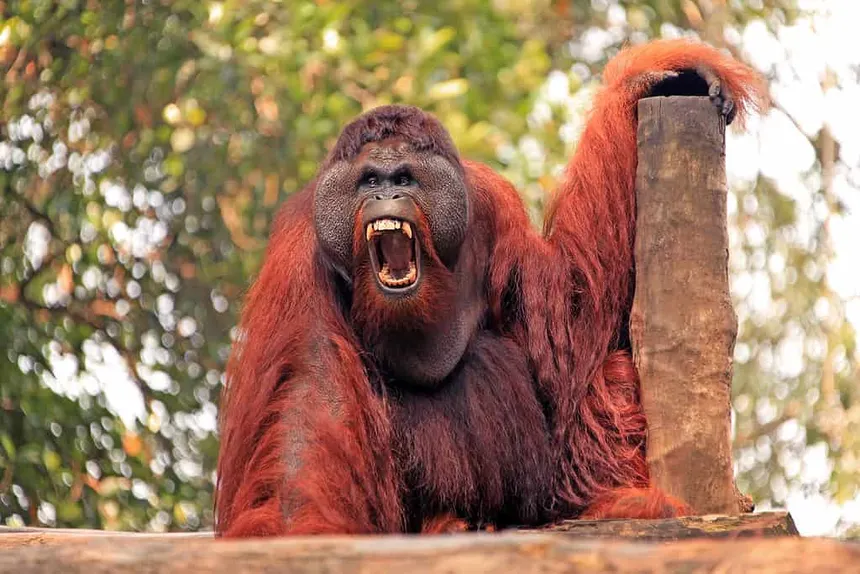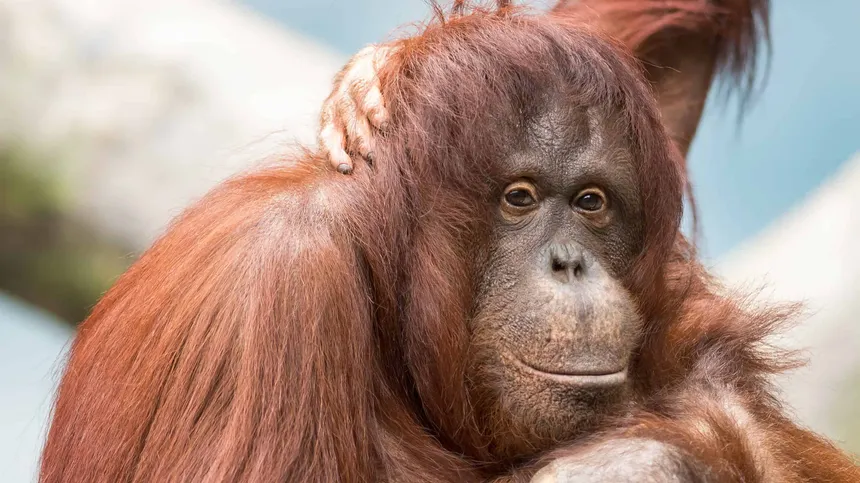“Orangutan Strength and Power: Gentle Giants or Hidden Danger?”

Orangutans—those shaggy, red-haired apes of Southeast Asia—are often portrayed as gentle, intelligent, and solitary creatures. But beneath their calm demeanor lies an immense physical strength and surprising potential for danger. These arboreal apes are not just strong; they are some of the most powerful primates on Earth, and understanding their strength is essential for appreciating both their biological capabilities and the respect they deserve in the wild or captivity.
In this detailed article, we explore the strength, anatomy, intelligence, and potential danger of orangutans—and what sets them apart in the primate kingdom.
🦧 Overview: Who Are Orangutans?
Orangutans are great apes native to the rainforests of Borneo and Sumatra, with three recognized species:
- Bornean orangutan (Pongo pygmaeus)
- Sumatran orangutan (Pongo abelii)
- Tapanuli orangutan (Pongo tapanuliensis)
They are highly intelligent, solitary, tree-dwelling apes known for their calm disposition, dexterity, and striking red hair. Adult males can weigh up to 90–100 kg (200–220 lbs) and measure 1.2–1.5 meters (4–5 feet) tall, but their true strength is far beyond what their size suggests.
💪 How Strong Are Orangutans?
Orangutans are 5 to 7 times stronger than humans, based on muscle density, grip strength, and lifting ability. Their strength is particularly concentrated in the upper body, making them experts at climbing, hanging, and swinging.
Key Facts About Orangutan Strength:
- Arm span: Up to 7 feet (2.1 meters), allowing them to swing effortlessly between trees.
- Grip strength: Exceptionally powerful—strong enough to bend metal bars, break thick branches, or rip apart logs.
- Muscle composition: They have denser muscle fibers than humans, optimized for slow, powerful movements rather than quick bursts.
- Orangutans can hang from one arm for extended periods, carry heavy loads in trees, and even disassemble cages or manipulate bolts if kept in captivity.
Example: In captivity, orangutans have been observed lifting weights over 200 pounds (90 kg) and bending iron bars that would be impossible for an average adult human to move.

🧠 Intelligence + Strength = A Formidable Combination
Orangutans are not just strong—they are exceptionally intelligent, ranking among the top non-human primates in cognitive ability.
They’ve been observed:
- Using tools (sticks to extract insects, leaves as umbrellas or sponges)
- Picking locks and unscrewing bolts in enclosures
- Imitating human behavior, including brushing teeth or starting fires
- Showing problem-solving abilities, long-term memory, and even elements of culture and social learning
This combination of physical strength and brainpower makes them incredibly capable—and potentially dangerous if provoked or stressed.
😮 Are Orangutans Dangerous?
Generally, no—orangutans are non-aggressive and naturally shy, especially in the wild. They prefer to avoid confrontation, whether with humans or other animals. But in certain situations, they can pose a threat:
1. In Captivity
- Orangutans can become territorial or defensive if they feel threatened.
- There are recorded incidents of orangutans attacking handlers in zoos, often due to stress, isolation, or lack of stimulation.
- Their strength can easily overpower even experienced caretakers if precautions aren’t followed.
2. Male Flanged Orangutans
- Dominant adult males develop cheek pads (flanges) and become more assertive and territorial.
- These males may show aggression toward rival males or humans if provoked.
- While attacks are rare, they can be devastating due to brute force.
3. When Provoked
- If an orangutan feels cornered, mistreated, or sees danger to its offspring, it may act defensively.
- Their bites can crush bones, and they may use tools or brute force if threatened.
🛠️ Human-Orangutan Conflict: A Real-World Concern
Orangutans have occasionally come into conflict with humans, particularly in regions where rainforests are being cleared for agriculture (like palm oil plantations).
- Orangutans may wander into human settlements, leading to tension or violent encounters.
- Rescue workers handling orphaned or displaced orangutans must use extreme caution due to the unpredictable behavior and sheer power of the animals.
🧬 Why Are Orangutans So Strong?
Their strength evolved to meet life in the treetops:
- Navigating the forest canopy requires powerful arms, shoulders, and fingers.
- Hanging, swinging (brachiation), and climbing all depend on sustained, controlled strength.
- Since they rarely travel on the ground, their lower bodies are less muscular, but their upper bodies are extremely developed.
🚨 Summary: Strength and Danger of Orangutans
| Feature | Description |
|---|---|
| Muscle Strength | 5–7x stronger than a human, especially in upper body |
| Grip | Can bend metal bars and hang from one arm for long periods |
| Weight | Males: 90–100 kg (200–220 lbs), Females: 30–50 kg (66–110 lbs) |
| Intelligence | Tool use, escape skills, mimicry, and high problem-solving ability |
| Danger Level | Low in the wild, but potentially dangerous if provoked, stressed, or mishandled |
| Behavior | Generally solitary, shy, and non-aggressive |
| Evolutionary Traits | Built for arboreal life—strong arms, wide reach, slow powerful movements |

🦧 Final Thoughts
Orangutans are gentle giants of the forest, blending immense strength with remarkable intelligence. While they are not naturally aggressive, their sheer power means they must be treated with respect and care, especially in captivity or conservation efforts.
Their declining numbers due to habitat loss, poaching, and the illegal pet trade make understanding and protecting them more important than ever. They are not dangerous predators, but rather powerful beings with the right to thrive in their natural world.



